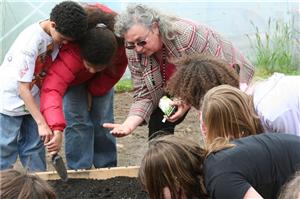Best Practices for Food Safety in the School Garden
Just like on the farm, the principles of Good Agricultural Practices and food handling techniques should be followed in a school garden to provide basic food safety.

Just like on the farm, the principles of Good Agricultural Practices and food handling techniques should be followed in a school garden to provide basic food safety.
Adapted from CFSC and National Farm to School Network Food Safety and School Garden Best Practices
At the bottom of the page are some great resources and guidelines to follow to ensure food is grown safely in the school garden. They go into more detail about food safety in the garden and give sample protocols that school districts are using. North Carolina State University and North Carolina Cooperative Extension recently published "Food Safety for School + Community Gardens," available at www.growingsafergardens.com.
Let's Move! Gardening Guide - School Garden: This downloadable checklist provides you with a step-by-step guide that offers important information about how to safely grow your own fruits and vegetables with your students. Check it out before you start your garden.
Yes it can! In 2009, the USDA released the School Garden Q&As memo regarding frequently asked questions about using food from school gardens in school lunch. In Washington State, as a statewide effort to provide guidance to encourage schools to offer salad bars that feature produce from school gardens and local farms, Washington State Department of Agriculture (WSDA) published SAFE Salad Bars in Schools - A Guide to School Food Service to minimize the risk of foodborn illnesses. The guide presents clear guidance to school district staff and decision makers, using state-level knowledge and expertise and consulting national sources. Please visit our "Salad Bar" page for the guide and other resources.
Before using produce from the school garden, the USDA recommends visiting the garden and asking the lead gardener about growing practices, including the history of the land use, water sources, soil sampling and results, use of fertilizers and pesticides, and animal control measures. To learn more, check out USDA and National Food Service Management Institute's Food Safety Tips for School Gardens, review the resources below:

Slow Food USA, in partnership with Whole Kids Foundation, has developed a toolkit to help school district food services safely bring school garden produce onto the lunch line! The toolkit builds off the successes and safety protocols of five school districts across the United States to provide templates and a step-by-step process to help District Food Services develop their own protocols.
In partnership with Common Threads in Whatcom County, Bellingham Public Schools in Washington is one of three school districts across the country currently participating in a Garden to Cafeteria pilot project supported by Slow Food USA and the Whole Kids Foundation. The pilot aims to develop and test protocol to allow garden grown produce to be regularly and safely enjoyed by kids as part of their school lunch program.
The Fresh Food for Lunch program of the South Whidbey School District provides school farm and garden grown vegetables to the school cafeterias, managed by Chartwells. Download the most recent Chartwells approved and updated SWSD Food and Garden Safety protocol.
A sample policy from Portland Public Schools in Portland, OR
A sample from Denver Public Schools